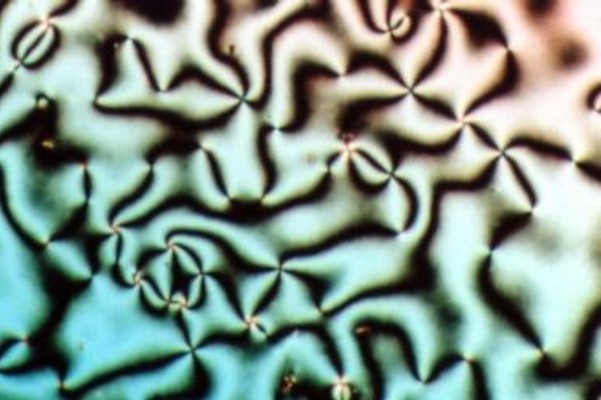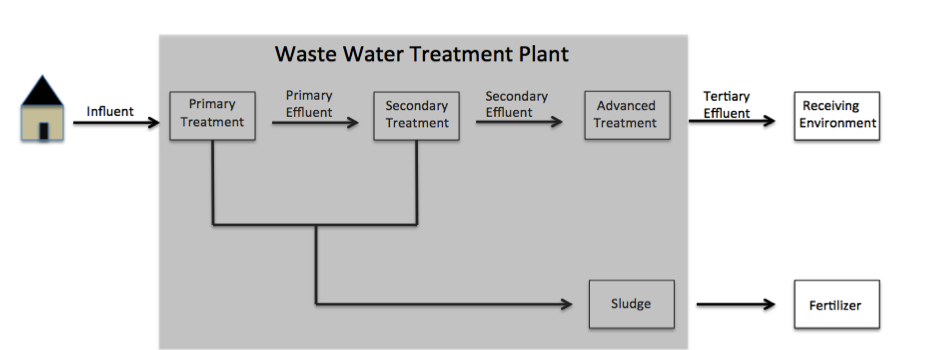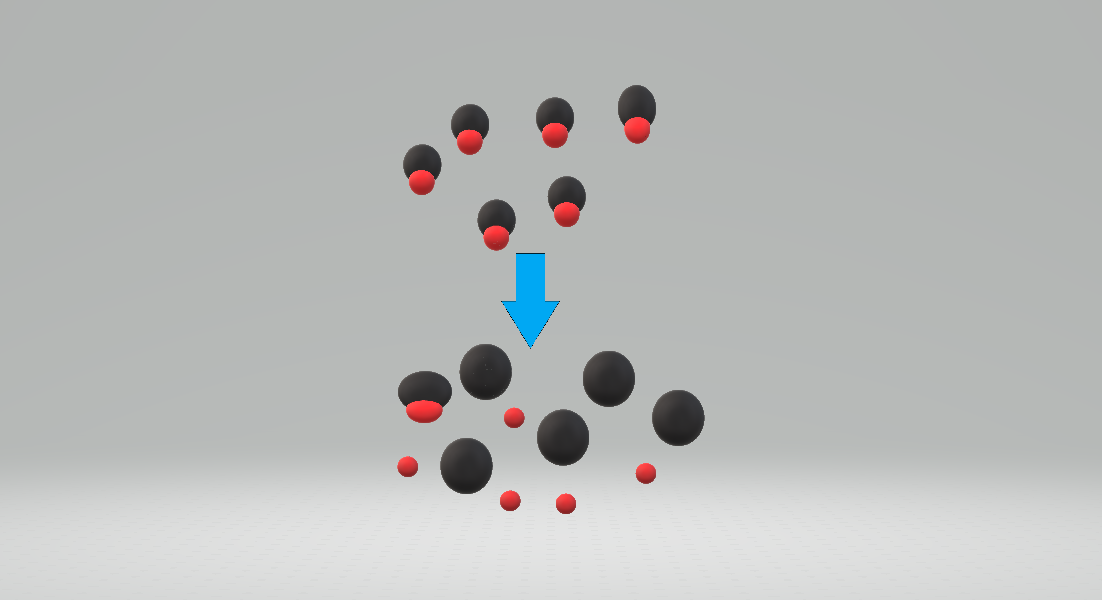|
Thermochrome
Thermochromism is the property of substances to change color due to a change in temperature. A mood ring is an example of this property used in a consumer product although thermochromism also has more practical uses, such as baby bottles, which change to a different color when cool enough to drink, or kettles which change color when water is at or near boiling point. Thermochromism is one of several types of chromism. Organic materials Thermochromatic liquid crystals The two common approaches are based on liquid crystals and leuco dyes. Liquid crystals are used in precision applications, as their responses can be engineered to accurate temperatures, but their color range is limited by their principle of operation. Leuco dyes allow wider range of colors to be used, but their response temperatures are more difficult to set with accuracy. Some liquid crystals are capable of displaying different colors at different temperatures. This change is dependent on selective reflection of ... [...More Info...] [...Related Items...] OR: [Wikipedia] [Google] [Baidu] |
Liquid Crystals
Liquid crystal (LC) is a state of matter whose properties are between those of conventional liquids and those of solid crystals. For example, a liquid crystal can flow like a liquid, but its molecules may be oriented in a common direction as in a solid. There are many types of LC phases, which can be distinguished by their optical properties (such as textures). The contrasting textures arise due to molecules within one area of material ("domain") being oriented in the same direction but different areas having different orientations. An LC material may not always be in an LC state of matter (just as water may be ice or water vapour). Liquid crystals can be divided into three main types: thermotropic, lyotropic, and metallotropic. Thermotropic and lyotropic liquid crystals consist mostly of organic molecules, although a few minerals are also known. Thermotropic LCs exhibit a phase transition into the LC phase as temperature changes. Lyotropic LCs exhibit phase transitions a ... [...More Info...] [...Related Items...] OR: [Wikipedia] [Google] [Baidu] |
Cholesteryl Benzoate
Cholesteryl benzoate, also called 5-cholesten-3-yl benzoate, is an organic chemical, an ester of cholesterol and benzoic acid. It is a liquid crystal material forming cholesteric liquid crystals with helical structure. It can be used with cholesteryl nonanoate and cholesteryl oleyl carbonate in some thermochromic liquid crystals. It is used in some hair colors, make-ups, and some other cosmetic preparations. It can be also used as a component of the liquid crystals used for liquid crystal displays. Cholesteryl benzoate was the first material in which liquid crystal properties were discovered. In the late 1880s Friedrich Reinitzer, an Austrian botanist Botany, also called plant science, is the branch of natural science and biology studying plants, especially Plant anatomy, their anatomy, Plant taxonomy, taxonomy, and Plant ecology, ecology. A botanist or plant scientist is a scientist who s ..., while studying the chemicals in plants, heated cholesteryl benzoate. At 145 ... [...More Info...] [...Related Items...] OR: [Wikipedia] [Google] [Baidu] |
Paraben
Parabens are organic compounds that are commonly used as preservatives in cosmetic and pharmaceutical products. They are esters of parahydroxybenzoic acid (also known as 4-hydroxybenzoic acid). Chemistry Structure and structure Parabens are esters of ''para''-hydroxy''ben''zoic acid, from which the name is derived. Common parabens include methylparaben (E number E218), ethylparaben (E214), propylparaben (E216), butylparaben and heptylparaben (E209). Less common parabens include isobutylparaben, isopropylparaben, benzylparaben and their sodium salts. They are produced by the esterification of ''para''-hydroxybenzoic acid with the appropriate alcohol, such as methanol, ethanol, or n-propanol. ''para''-Hydroxybenzoic acid is in turn produced industrially from a modification of the Kolbe-Schmitt reaction, using potassium phenoxide and carbon dioxide. Biological mode of action Parabens are active against a broad spectrum of microorganisms. However, their antibacteri ... [...More Info...] [...Related Items...] OR: [Wikipedia] [Google] [Baidu] |
Bisphenol A
Bisphenol A (BPA) is a chemical compound primarily used in the manufacturing of various plastics. It is a colourless solid which is Solubility, soluble in most common organic solvents, but has very poor solubility in water. BPA is produced on an industrial scale by the condensation reaction of phenol and acetone. Global production in 2022 was estimated to be in the region of 10 million tonnes. BPA's largest single application is as a co-monomer in the production of polycarbonates, which accounts for 65–70% of all BPA production. The manufacturing of epoxy resins and vinyl ester resins account for 25–30% of BPA use. The remaining 5% is used as a major component of several high-performance plastics, and as a minor additive in polyvinyl chloride (PVC), polyurethane, thermal paper, and several other materials. It is not a plasticizer, although it is often wrongly labelled as such. The health effects of BPA have been the subject of prolonged public and scientific debate. BPA is ... [...More Info...] [...Related Items...] OR: [Wikipedia] [Google] [Baidu] |
Spiropyran
A spiropyran is a type of photochromic organic chemical compound, characterized by their ability to reversibly switch between two structural forms—spiropyran and merocyanine—upon exposure to light or other external stimuli. This reversible transformation alters their optical and electronic properties, making them valuable in various applications, including molecular switches, optical data storage, sensors, and smart materials. History Spiropyrans were discovered in the early twentieth century, but it was not until 1952 that their photochromic properties were formally documented by chemists Fischer and Gerhard Hirshberg. Their pioneering work demonstrated that spiropyrans undergo reversible structural and color changes when exposed to ultraviolet light, a phenomenon that sparked widespread interest in photoresponsive organic compounds. Throughout the latter half of the twentieth century, advancements in synthetic methods enabled the development of a wide range of spiropyran deriv ... [...More Info...] [...Related Items...] OR: [Wikipedia] [Google] [Baidu] |
Fluoran
Fluoran is a triarylmethane dye. It is the structural core of a variety of other dyes. These dyes have a variety of applications such as chemical stains (for example eosins) and in thermal paper Thermal paper (often supplied in roll form, and sometimes referred to as an audit roll) is a special fine paper that is coated with a material formulated to change color locally when exposed to heat. It is used in thermal printers, particularly .... Black 305 is a common leuco dye product for thermal paper. References Triarylmethane dyes Spiro compounds Lactones {{organic-compound-stub ... [...More Info...] [...Related Items...] OR: [Wikipedia] [Google] [Baidu] |
Spirolactone
Spirolactones are a class of functional group in organic chemistry featuring a cyclic ester attached spiro to another ring system. The name is also used to refer to a class of synthetic steroids, called steroid-17α-spirolactones, 17α-spirolactosteroids, or simply 17α-spirolactones, which feature their spirolactone group at the C17α position. They are antimineralocorticoids, or antagonists of the mineralocorticoid receptor (which is activated predominantly by the mineralocorticoid steroid hormone aldosterone), and have been employed clinically as potassium-sparing diuretics. Some also possess progestogenic and/or antiandrogen properties, which have both contributed to side effects and been utilized for medical indications (e.g., spironolactone as an antiandrogen, and drospirenone as a progestin). The spirolactones were developed by G. D. Searle & Company in the 1950s and thereafter and were denoted as "SC" compounds (e.g., SC-9420 for spironolactone). The spirolacton ... [...More Info...] [...Related Items...] OR: [Wikipedia] [Google] [Baidu] |
Halochromism
A halochromic material is a material which changes colour when pH changes occur. The term ‘ chromic’ is defined for materials that can change colour reversibly with the presence of an external factor. In this case, the factor is pH. One class of compounds with this property are pH indicators. Halochromic substances are suited for use in environments where pH changes occur frequently, or places where changes in pH are extreme. Halochromic substances detect alterations in the acidity of substances, like detection of corrosion in metals. Halochromic substances may be used as indicators to determine the pH of solutions of unknown pH. The colour obtained is compared with the colour obtained when the indicator is mixed with solutions of known pH. The pH of the unknown solution can then be estimated. Obvious disadvantages of this method include its dependency on the colour sensitivity of the human eye, and that unknown solutions that are already coloured cannot be used. The colour ... [...More Info...] [...Related Items...] OR: [Wikipedia] [Google] [Baidu] |
Dodecanol
Dodecanol , or lauryl alcohol, is an organic compound produced industrially from palm kernel oil or coconut oil. It is a fatty alcohol. Sulfate esters of lauryl alcohol, especially sodium lauryl sulfate, are very widely used as surfactants. Sodium lauryl sulfate and the related dodecanol derivatives ammonium lauryl sulfate and sodium laureth sulfate are all used in shampoos. Dodecanol is tasteless, colorless, and has a floral odor. Production and use In 1993, the European demand of dodecanol was around 60,000 tonnes per year. It can be obtained from palm oil or coconut oil fatty acids and methyl esters by hydrogenation. It may also be produced synthetically via the Ziegler process. A classic laboratory method involves Bouveault-Blanc reduction of ethyl laurate. Dodecanol is used to make surfactants, which are used in lubricating oils, and pharmaceuticals. Millions of tons of sodium dodecylsulfate (SDS) are produced annually by sulfation of dodecyl alcohol: : : Dodecanol is ... [...More Info...] [...Related Items...] OR: [Wikipedia] [Google] [Baidu] |
Weak Acid
Acid strength is the tendency of an acid, symbolised by the chemical formula , to dissociate into a proton, , and an anion, . The dissociation or ionization of a strong acid in solution is effectively complete, except in its most concentrated solutions. : Examples of strong acids are hydrochloric acid (), perchloric acid (), nitric acid () and sulfuric acid (). A weak acid is only partially dissociated, or is partly ionized in water with both the undissociated acid and its dissociation products being present, in solution, in equilibrium with each other. : Acetic acid () is an example of a weak acid. The strength of a weak acid is quantified by its acid dissociation constant, K_a value. The strength of a weak organic acid may depend on substituent effects. The strength of an inorganic acid is dependent on the oxidation state for the atom to which the proton may be attached. Acid strength is solvent-dependent. For example, hydrogen chloride is a strong acid in aqueous solu ... [...More Info...] [...Related Items...] OR: [Wikipedia] [Google] [Baidu] |
Crystal Violet Lactone
Crystal violet lactone (CVL) is a leuco dye, a lactone derivate of crystal violet 10B. In pure state it is a slightly yellowish crystalline powder, soluble in nonpolar or slightly polar organic solvents. The central carbon in the leuco form is in a tetrahedral configuration, with four covalent bonds. In an acidic environment, the lactone ring is broken, with the oxygen detaching from the central carbon. This now-trivalent position is a planar carbocation that is resonance stabilized, interconnecting the π systems of the aromatic rings and the amino functional groups. This single large conjugated system is a chromophore with strong absorption in visible spectrum, giving this compound its distinctive color. This chemical is usually drawn in the resonance structure with the cation on nitrogen. : It was the first dye used in carbonless copy papers, and it is still widely used in this application. It is also the leuco dye component in some thermochromic dyes, e.g. in the Hypercolo ... [...More Info...] [...Related Items...] OR: [Wikipedia] [Google] [Baidu] |
Hypercolor
Hypercolor was a line of clothing, mainly T-shirts and shorts, that changed color with heat. They were manufactured by Generra Sportswear Company of Seattle and marketed in the United States as Generra Hypercolor or Generra Hypergrafix and elsewhere as Global Hypercolor. They contained a thermochromic pigment made by Matsui Shikiso Chemical of Japan, that changed between two colors—one when cold, one when warm. The shirts were produced with several color change choices beginning in 1991. The effect could easily be permanently damaged, particularly when the clothing was washed in hotter than recommended water, ironed, bleached, or tumble-dried. Generra Sportswear Co. had originally been founded as a men's sportswear distributor and importer in Seattle in 1980. The company was sold to Texas-based Farah Manufacturing Co. in 1984 and bought back by its founders in 1989. In 1986, the company added childrenswear and womenswear items to their portfolio. They struggled to meet the ... [...More Info...] [...Related Items...] OR: [Wikipedia] [Google] [Baidu] |




